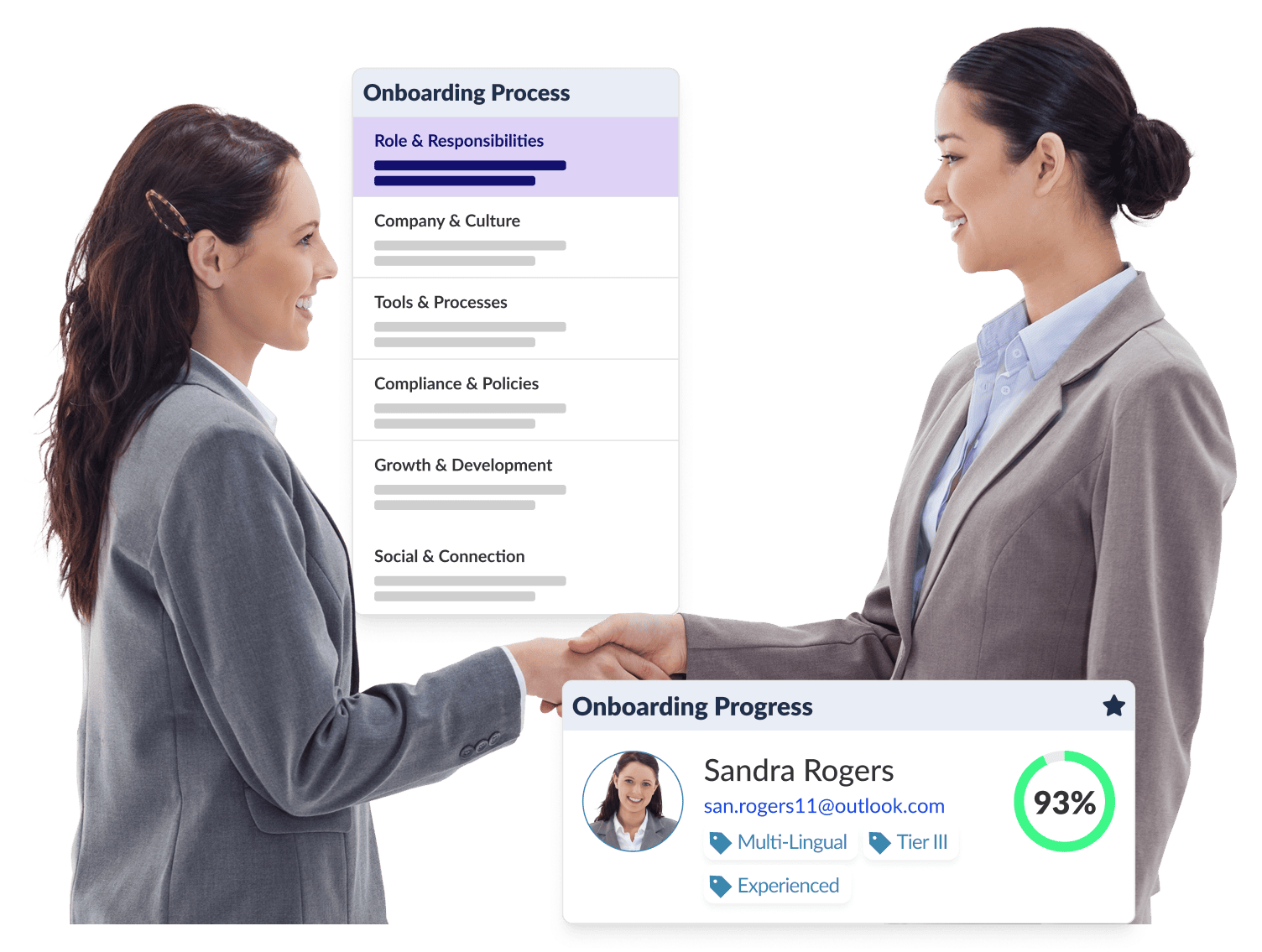
How to Combat Employee Turnover
Address issues with job satisfaction, career development and leadership to reduce turnover.
Written by
VidCruiter Editorial TeamReviewed by
VidCruiter Editorial TeamLast Modified
Oct 8, 2025
The onboarding process gives employees the knowledge and support needed to ‘get up to speed’ as an enthusiastic team member. But ideally, it also lays the foundation for employee engagement and development throughout a person’s tenure, helping you to build a motivated, high-performing workplace culture.
Ineffective onboarding can have the opposite effect, because it gets the relationship off on the wrong foot. When new hires don’t fully grasp where they fit within your organization and what it takes to belong and be recognized, disengagement and turnover can follow.
Avoid wasted recruitment spend, and improve time to productivity, by learning how to build an effective onboarding process for new hires.

Starting a new job is daunting. So many new faces, unfamiliar ways of doing things, and high expectations. Onboarding helps new employees make the transition with confidence.
Six major stages of the onboarding process
Onboarding typically includes a combination of these elements:
There are many logistical elements to onboarding. New hires might need a laptop, uniform or access to a work vehicle. They might need instruction on how to use certain equipment, what your cybersecurity policies are, or when to submit their timesheets.
But there’s more to it if you want employees to feel deeply embedded and inspired. A robust onboarding process helps employees understand:
While onboarding usually involves a series of steps performed over a specific timeframe, it isn’t really a discrete piece of work that ends abruptly. Done well, an onboarding process creates a seamless bridge between your talent acquisition and talent management strategies.
Organizations risk undoing the benefits of a cost-effective recruitment process if employees form a negative impression early on.
Around one in five new hires will leave within 12 months of accepting a job, according to analysis of cross-industry data by the American Productivity and Quality Center (APQC). Excessively high new hire turnover increases recruitment and training costs, and it can be a sign you’re not investing enough in your HR initiatives, according to APQC Principal Research Lead, Elissa Tucker.
“For example, cutting too much from training and development may result in a subpar onboarding experience that both increases time to productivity and leaves employees less engaged and more likely to leave as a result,” Tucker said.
Conversely, effective onboarding can:
For example, organizations that have been affected by candidate ghosting might benefit from comprehensive onboarding that includes a pre-boarding stage, because forging bonds with a new hire increases their commitment. A poll by job board Indeed found 70% of U.S. employees think ghosting, including not showing up on the first day, is fair.

Onboarding maturity drives engagement
Organizations with well-designed onboarding that’s linked to learning and development achieve 80% higher new hire engagement and 103% better time-to-proficiency (Brandon Hall Group).
Onboarding will look different depending on an organisation’s size and industry, and the employee’s role and experience level. New hires in entry-level roles with a large on-the-job training component may need a longer onboarding period.
Start with the recruitment process
Employee branding and the candidate experience both lead into onboarding and both will inextricably shape your employees’ perceptions. Onboarding is enhanced when recruiters meet candidates’ expectations for a clearly-communicated hiring process, and proactively share information about the position, the company and what their first 30 days in the role will look like. Pre-boarding can also be a good opportunity to get necessary paperwork squared away.
Identify what’s relevant to new hires
Document the whole-of-company policies and processes that every new hire needs to be across, which might include an employee handbook, dress code, attendance and leave policies, or diversity, equity and inclusion (DEI) training.
Clarify the kind of information that leaders will need to impart, and activities they should lead. For instance, a direct manager might share how team meetings are run and schedule a welcome lunch. A department head might meet with the new hire to explain the team’s structure and how its work aligns with broader strategies.
Then identify role-specific skills, processes and expectations. For example, new members of the sales team may need to be provided with your sales methodology, product-specific training, competitor battle cards, and access to your customer relationship management tool.
Determine and assign practical tasks
End-to-end onboarding requires a cross-functional effort that draws on employees from varied departments including HR, finance, IT, operations, marketing and the C-suite. Employees won’t feel warmly welcomed if they show up to find no one remembered to print them a name badge, set up a workspace, or organize their log-in credentials.
Determine exactly what needs to happen, when the task needs to be initiated in order to be completed before the new hire’s start date, and which team or individual is responsible.
Establish a realistic timeline
A clearer picture of the breadth of information, activities and logistical requirements related to onboarding lets your organization schedule workflows and events within a structured timeline. Many organizations build an onboarding process around a 30-60-90 day plan, which outlines a professional development roadmap for an employee’s first three months in a role.
Develop onboarding resources and capabilities
Finally, it’s smart to streamline the onboarding process, by developing standardized procedures, checklists and templates. However, emphasize to managers and others involved in onboarding that it’s not a box-ticking exercise. Some new hires may need more time or personalized attention to become fully integrated.
Empower managers to gather meaningful feedback from new hires, spot the signs a new employee may be struggling, and be prepared to re-onboard or provide extra guidance.
Consider the need for onboarding technology that helps you automate key steps and easily collect feedback, as well as track tasks and deadlines related to onboarding and employee learning.
The biggest mistake to avoid is failing to offer or delaying employee onboarding until it’s too late to make a difference.
Also, don’t fall into the trap of believing that only junior team members need a thorough onboarding process. Global analytics firm Gallup identified a substantial drop in manager engagement and wellbeing in its State of the Global Workplace 2025 Report. Gallup suggests that providing basic role training for every manager is the most achievable opportunity to cut disengagement and lift productivity.
If you’re hiring people to lead and develop others, onboarding is the best time to help them understand what ‘best practice’ management means in your organization — and show them that they will be supported and given opportunities to develop too.

Here is an example of an onboarding checklist for a new hire’s first 30 days:
Not being equipped to help new hires land on their feet negates the time, money and effort spent on finding and hiring talented people in the first place. Employees will integrate faster and build lasting relationships that help them feel motivated and loyal to your organization when you get onboarding right.

Common terms used interchangeably with onboarding are orientation, new hire welcome or induction. Orientation is about getting your new hire situated initially, and is usually viewed as part of a longer onboarding process. There’s also cross-boarding, which are procedures designed to help existing employees adapt to a new role within the same organization.
Weaving in social connection and peer-to-peer learning through mentoring is one of the most powerful onboarding experiences. A well-known Gartner study on mentoring involving 1,000 employees over a 5-year period found mentees were promoted five times more often, and retention rates for mentees was also vastly better (72% v. 49% for employees not in the program).
Onboarding processes vary in length between 1-2 weeks to 6-12 months. A common onboarding timeline for in-depth, structured programs is three months. Skimping on onboarding doesn’t make sense when you acknowledge that well-executed onboarding can accelerate a new hire’s time to productivity.
Modernize your hiring process with expert insights and advice.